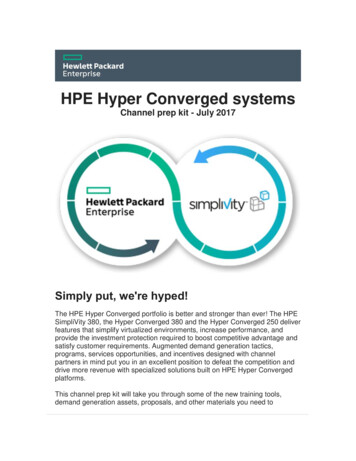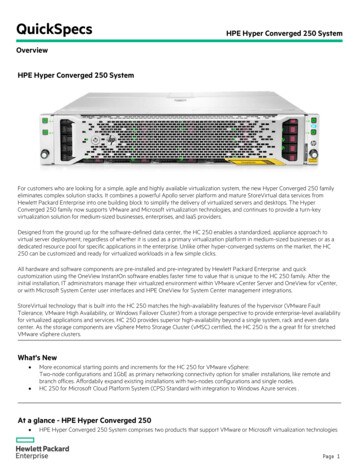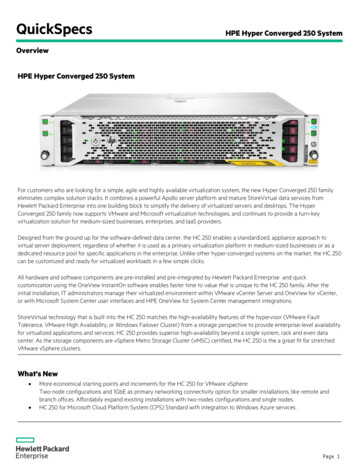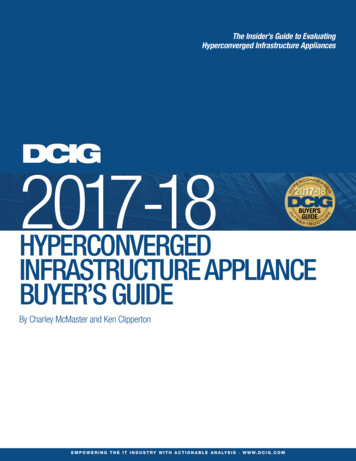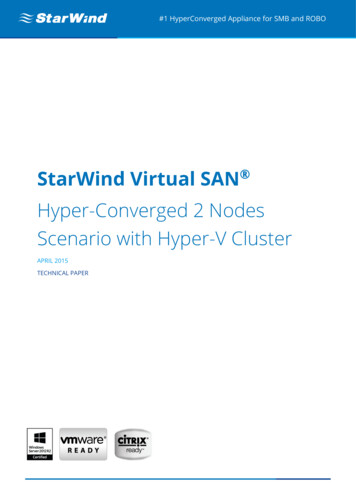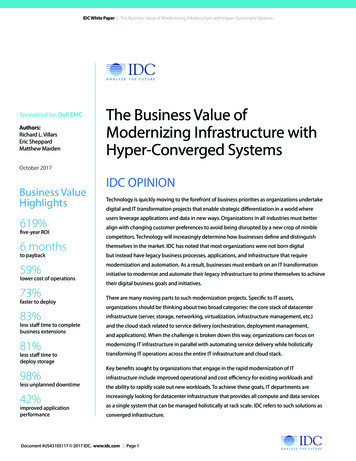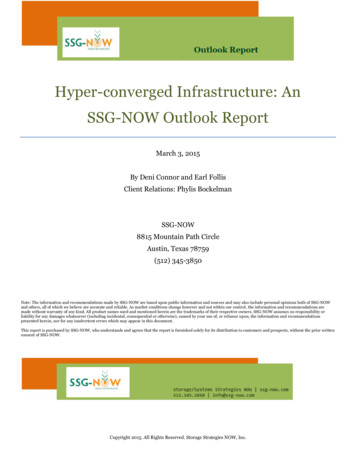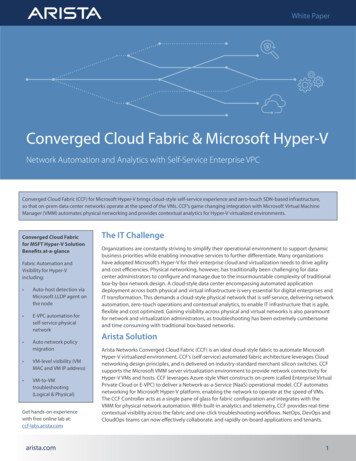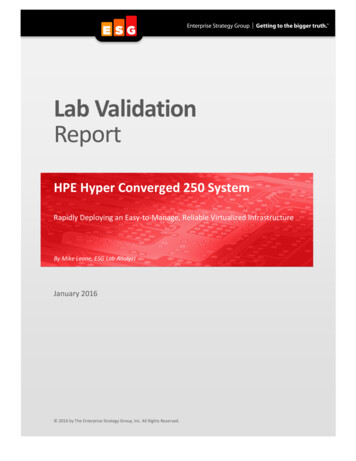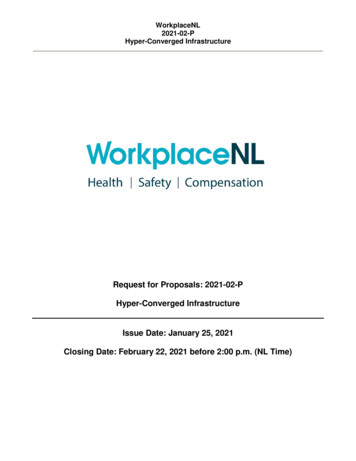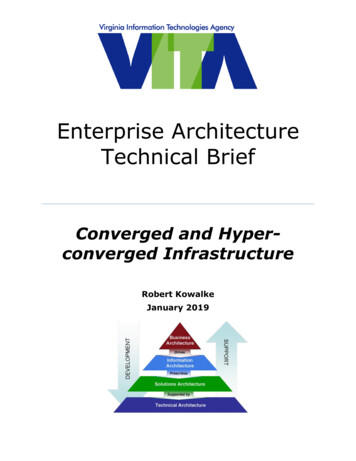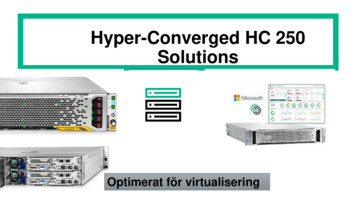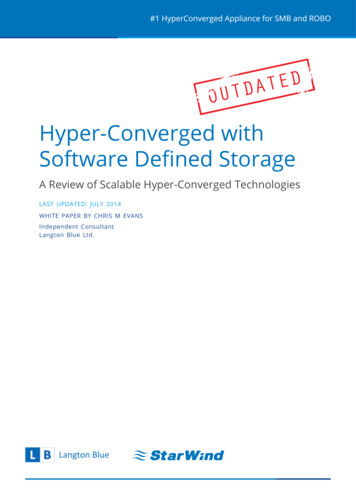
Transcription
Hyper-Converged withSoftware Defined StorageA Review of Scalable Hyper-Converged TechnologiesLAST UPDATED: JULY 2014WHITE PAPER BY CHRIS M EVANSIndependent ConsultantLangton Blue Ltd.
Hyper-Converged withSoftware Defined StorageIntroduction and Executive SummaryAs virtualisation technology matures and businesses look to deploy ever more efficientscalable solutions, a new breed of technology has emerged. Hyper-convergedinfrastructure solutions merge compute, storage and networking together to takethings a step further than the simple packaging offered by the first generation ofconverged infrastructure systems.The first generation of converged solutions simply packaged components together intoa single rack-based deployment that could be ordered under a single SKU (StockKeeping Unit). Many solutions were static in nature and provided companies nothingmore than a single point of contact and some savings in solutions testing.Hyper-converged solutions merge server and storage into the same form factor,eliminating the need to deploy and manage separate physical components. Bringingthese constituent parts together allows simplification of the hardware and the ability tomove many features to software, including data protection, data reduction, resiliencyand the ability to scale out.Vendor offerings are not restricted to packaged hardware and many solutions areavailable in software-only format. These kinds of products can be beneficial to thecustomer in many ways, fitting in with existing hardware infrastructure standards andpractices. Ultimately the features of the software define any hyper-converged solution.Some of the most common vendor products are discussed in this paper.The conclusion of this white paper is a feature comparison between Virtual SAN fromVMware and Virtual SAN from StarWind Software.VMware Virtual SAN is a version 1.0 product, first shipped with VMware vSphere 5.5 U1and higher. It provides a distributed storage environment across multiple nodes in avSphere cluster using local DAS storage. As a first release, Virtual SAN offers limiteddata efficiency features, supporting only thin provisioning.StarWind Virtual SAN is the evolution of the StarWind iSCSI Target, which has been indevelopment since 2003. The Virtual SAN software integrates into Windows Serverenvironments (2008 R2 and later) adding data services (availability, performance,efficiency) to complement those offered on the Windows platform.The comparisons showed that StarWind Virtual SAN provides a greater set of featurescompared to VMware Virtual SAN, with specific advantages in data protection, dataefficiency and I/O performance.WHITE PAPER2
Hyper-Converged withSoftware Defined StoragePutting a Definition to Hyper-ConvergeHyper-converged solutions follow on from the first wave ofconsolidated hardware and software offerings known as ConvergedVMInfrastructure. Converged Infrastructure solutions have been aroundVMVMsince late 2009 and package servers (compute) with storage andnetworking to deliver an “all-in-one” offering, usually managed bycustom software that provides a layer of orchestration to provisionand manage virtual machines.Shared StorageMany converged solutions are static in nature, with little flexibility toNetworkingexpand the configurations and so do little more than providecustomers with a “single throat to choke”, alleviating some of theoverhead of certifying multiple components into a single solution.Some converged infrastructure offerings aren’t delivered as a productand are classed as “reference architectures”, requiring the customerto purchase the individual components separately. However allConverged SolutionsConverged Infrastructure solutions place all of the hardwarecomponents into a standard rack configuration that still ultimatelyrequires storage management, networking and server skills.Hyper-converged solutions take things a step further than simple product packaging by eliminating theseparate storage and server components, merging them together into a single form-factor. The “secretsauce” is delivered in the software, which provides the functionality of converged solutions (and more)without the additional hardware and management overhead.VMVMVMStarWind Virtual SANVMStarWind Virtual SANStarWind Virtual ronizationNICNICCompute and StorageVMVMCompute and Storage«Mirror» by StarWind Virtual SANVMNICVMVMCompute and Storage«Mirror» by StarWind Virtual SANVMHyper-converged solutions are divided into two main categories; hardware-based and software-basedofferings.WHITE PAPER3
Hyper-Converged withSoftware Defined StorageHardware-basedHardware-based solutions take standard off the shelf servers, integrating networking and storage intothe chassis to create an appliance. The appliances will typically be configured with a number of differentstorage options; hard drives for capacity and flash in multiple forms to deliver I/O at low latency. Thehardware will be supplemented with software that provides the functionality of a file system withfeatures for data protection & reduction, automated provisioning, monitoring the configuration andmanaging the expansion of the system.Software-basedThese solutions deploy directly onto customer hardware, providing the same level of software featuresas hardware-only solutions. As no hardware is shipped, the customer is responsible for choosingtechnology that works with the hyper- converged solution and that means ensuring components areboth reliable and able to perform at the level of workload required. Software solutions may also havedifferent charging models, as there are no hardware maintenance or upgrades to consider. As before,software-based solutions are all about the “secret sauce” in the software itself, which implements theadvanced data management and availability features.The Good and Bad Sides of Hyper-ConvergenceThe idea behind hyper-converged solutions is one of simplification. Large enterprises are able to supportsignificant product engineering teams to validate and build configurations to their requirements.However many small and medium enterprises lack the funding and skills to put in the same level of duediligence and design and of course many simply don’t have the economies of scale compared to largeenterprises. These smaller companies have relied on vendors to provide that level of support andguidance on their behalf. Hyper-converged solutions offer benefits in terms of simplicity and reducedcost as a result of:Removal of dedicated hardware – hyper-converged solutions specifically allow the removal ofdedicated storage hardware, moving permanent storage media back into the server in what wouldhave been previously described as DAS. Storage capacity and performance growth is managedthrough scaling out the hardware, distributing data across all nodes and so reducing theshortcomings of legacy DAS-style deployments.Hardware agnostic – software-only solutions can be deployed on a wide variety of hardwareplatforms from the major server vendors. We have already seen HP, Dell and others come forwardwith reference architectures and designs for VMware Virtual SAN, which also has a specific hardwaresupport matrix. Allowing the customer to choose their own hardware means solutions can bedeployed on hardware the customer is familiar with (reducing training costs) and already havecontracts in place for support.WHITE PAPER4
Hyper-Converged withSoftware Defined StorageSimplification – simplifying solutions is more than just removing components such as storage. Forhardware offerings, vendors have tested and validated their hardware configurations andunderstood the scalability capabilities. Many solutions allow for capacity growth by adding newnodes or additional components, thereby easing migration issues. Software solutions provideoptions to migrate data between tiers or between servers, allowing a more managed growth strategywithout application downtime.Increased efficiency – Hyper-converged solutions potentially offer greater performanceimprovements than traditional deployments as storage latency is significantly reduced by placingactive data closer to the processor. The distributed nature of hyper-converged solutions means allcomponents are being used all of the time, for maximum efficiency.With hyper-converged solutions, there is a debate on whether the software components should bedeployed within the kernel of the hypervisor or within a virtual machine. Kernel-based solutions such asVMware Virtual SAN are more closely integrated with the operating system and vendors will sell thevirtues of closer software integration. However these solutions are also tied to the hypervisor for bothfeature and fix upgrades, potentially making maintenance of a hyper-converged solution more difficult.By comparison, VM-based or driver-based hyper-converged solutions have the benefit of being moreeasily upgradable as they have little if no dependency on the hypervisor platform, other than to supportspecific features and configurations. The downside for these configurations is that the storagecomponent is run in parallel with virtual machines serving production workloads and so there is a risk ofresource contention, which the user needs to manage.Features to Look Out forWhat features are important and should be available in hyper-converged solutions? Although vendorsolutions vary considerably, there is a set of basic features that should be deliverable in all solutions.High Performance - hyper-convergence provides the ability to deliver performance in a number ofways. Storage is more closely located to the processor (compared to converged solutions), reducinglatency. Applications and storage can also be distributed across a hyper-converged cluster, allowinga flexible use of available resources, reducing bottlenecks and improving overall throughput.High Scalability – hyper-converged solutions should scale well. Most are built around the concept ofgrouping multiple nodes (i.e. physical servers) together, with each node bringing processing capacity,storage capacity/performance and network bandwidth. As solutions scale, more nodes can be added,with the restriction that the maximum size of a virtual machine will be limited to the capacity of onenode and the overall size of a cluster may be limited to the restrictions in the size of the cluster.Data Efficiency – most solutions offer savings in storage capacity through the use of a number ofdata reduction techniques including thin provisioning, compression and de-duplication. The savingsWHITE PAPER5
Hyper-Converged withSoftware Defined Storageachieved depend on the type of data being processed, with VDI and virtual server environmentsseeing the most benefit. Figures quoted by vendors range from 2:1 for structured to 10:1 for VDI,with a typical average 6:1 savings ratio.Data Protection – Hyper-converged solutions should offer data protection features. These can bedivided into local resiliency (managing component and node failures) and site resiliency (throughreplication). The resiliency that was previously built into external storage arrays has to be deliveredby the hyper-converged platform. Scale out solutions use features such as distributed file systems toachieve this, whereas the more basic offerings simply mirror data between physical disk devices.Remote replication provides for geographic resiliency and can be used as part of a wider dataprotection strategy.Management/Reporting – Effective management is a key component of any hyper-convergedsolution. Management tool features include visualisation of the infrastructure, automatedprovisioning of VMs, automation/balancing of cluster resources and alerting.Security – Security is a concern for any solution; where hard drives and flash storage is used in theserver, there are issues of data encryption at rest and of course for data in flight, encryption acrossWAN links. In traditional infrastructure deployments using shared SAN or NAS storage, vendors offerencryption for physical disk and in most cases will certify the destruction of hard drives removedfrom arrays. However with hyper-converged solutions, the onus is on the customer to destroy drivesor ensure data at rest is encrypted on disk in the first instance.Licensing – cost is a major factor in implementing hyper-converged solutions. The cost model forhardware is typically based on the hardware cost itself, with annual maintenance. Pricing may be based“per node” or CPU socket and vary according to the node specifications. Software-only solutions can belicenced differently, including per TB of storage deployed or per node configured (irrespective of thenode capabilities). As with traditional infrastructure deployments, understanding the TCO of a solutioncan be complex and even hyper-converged solutions need to be carefully validated.Vendor Roundup and ComparisonsWhich vendors are offering hyper-converged solution in the market place today?HardwareNutanix was founded in 2009 and released their first product (called the Virtual Compute Platform)to the market in 2011 under the marketing slogan “No SAN”. A VCP deployment consists of at leastthree physical nodes, combined in a cluster. Each node implements a virtual machine to hoststorage resources that are combined to create a cluster-wide scale-out file system (called SOCS –Scale Out Converged Storage). Hypervisor hosts access the storage through iSCSI LUNs presentedfrom the virtual machines. VCP offers a range of data reduction features and supports VMwarevSphere, Microsoft Hyper-V and KVM platforms.WHITE PAPER6
Hyper-Converged withSoftware Defined StorageScale Computing – Scale is a startup company focusing on the SMB end of hyper-convergedsolutions. Their platform, known as HC3, combines compute, networking and storage using opensource KVM as the hypervisor and their own in-house developed object store technology. Scale havedeveloped an entire ecosystem around KVM with their own Software Defined Storage object layerknown as SCRIBE (Scale Computing Reliable Independent Block Engine) and a state engine which isused to manage the status of hardware and software components in the ecosystem. This makesHC3 very much a software-based solution.SimpliVity Inc – SimpliVity is a startup company, also founded in 2009 that offers a hardware-basedscale out solution. Their offering is known as OmniCube and encompasses, compute, storage andnetworking in a single hardware platform with additional features such as WAN optimisation fordistributed nodes, de-duplication and global scale out. OmniCube achieves high I/O performancelevels through the use of a dedicated PCIe module that manages inline compression anddeduplication of data. The data deduplication feature is global, allowing virtual machines to move toremote nodes by transferring only the uncommon de-duplicated data.SoftwareAtlantis Computing – Atlantis initially focused on the VDI market with their original releases of ILIO(Inline Image Optimisation). The company recently released ILIO USX, a version of the softwarefocused on using flash and system memory to accelerate virtual machine deployments on VMwarevSphere, although the technology is hypervisor agnostic and will work across hypervisor types.DataCore SANsymphony – DataCore Software has been in the market since 1998 and recentlyreleased version 10 of their flagship SANsymphony storage virtualisation platform. SANsymphonyoffers a wide range of features, including asynchronous replication, storage pooling and tiering,caching, thin provisioning and CDP. As yet the product does not offer compression or datadeduplication.Maxta MxSP – Maxta Inc was founded in 2009 and is a startup company building a distributedstorage solution for virtual server environments called Maxta Storage Platform (MxSP). The MxSPsoftware implements a shared storage environment with features including thin provisioning, inlinecompression and de-duplication and high availability through virtual machine failover.StarWind Software – StarWind have been providing storage solutions for Windows Serverenvironments since 2003. Their iSCSI target software has evolved into their current flagship product,StarWind Virtual SAN. The software extends and enhances the features of Windows Server withfeatures including scale-up and scale-out deployments, fault tolerance and high availability, caching,asynchronous replication, automated storage tiering, deduplication and compression.Virtual SAN can be deployed in both Windows Hyper-V and VMware vSphere environments tocreated hyper-converged infrastructure solutions.WHITE PAPER7
Hyper-Converged withSoftware Defined StorageVMware Virtual SAN – VMware originally announced Virtual SAN at VMWorld 2013 in San Francisco.The platform was released in beta in September 2013 and went GA in March 2014. Virtual SANimplements a distributed datastore across a number of clustered vSphere ESXi hosts, aggregatingdisk storage and using flash as a read and write I/O accelerator. Virtual SAN is only at release 1.0 andthis is highlighted in some of the features that are (and are not) implemented. Data protection isachieved solely through mirroring (with additional resiliency achieved through more mirrors, alsoknown as replicas). Data deduplication is currently not supported. Flash storage is used as a cacheonly and not as a permanent store for data.Virtual SAN Comparisons – VMware and StarwindVMware Virtual SANVirtual SAN, more commonly known as Virtual SAN from VMwarehas been in general availability since the release of VMwareVMVMVMVMvCenter Server 5.5 Update 1 on 11 March 2014. Virtual SAN wasadded as a feature to the vSphere ESXi hypervisor but requiresvCenter for operations and licencing.VMware vCenter ServerA Virtual SAN cluster comprises of a minimum of three vSphereESXi 5.5 hosts in order to satisfy the minimum requirements ofdata redundancy. This is broken down into two servers which storemirrors (or replicas) of virtual machines in a cluster-wide distributeddatastore, plus a third server to act as a Witness, in the event thatnetworking problems make it impossible to communicate betweenthe data hosts – otherwise known as the classic “split brain”scenario. Operationally, Virtual SAN can potentially create moreWitnesses depending on the number of hosts in a cluster and theVirtual SANlayout of data across the cluster members.Virtual SAN uses local resources from each host, building pools of disks and flash storage into a singledistributed datastore. Each contributing host must have a minimum of one hard disk and one solid statedisk drive, although not all hosts in a cluster need to contribute to the storage resources but may stillconsume them.Virtual SAN storage policies are applied to virtual machines through the use of rules; a policy isconstructed using one or more rules and vSphere then applies those rules when storing the virtualmachine in the distributed Virtual SAN datastore. Currently five rules (or capabilities) exist:Number of Failures to Tolerate – number of host/network/disk failures that may occur while stillensuring VM availability.WHITE PAPER8
Hyper-Converged withSoftware Defined StorageNumber of Disk Stripes Per Object – number of physical disks across which to stripe each replicaof a virtual machine (depending on physical disks available).Flash Read Cache Reservation – a percentage figure of the virtual machine VMDK that should beretained in flash.Object Space Reservation – a percentage figure indicating how much of the configured capacity ofa VM should be reserved on disk (a figure of 100% results in a fully provisioned “thick” VM).Force Provisioning – indicates whether provisioning of a VM should still be done, even if it breaksthe VM Storage Policy rules for availability.Virtual SAN is very much a version 1.0 product; there is no support for data compression orde-duplication and the only policy for data protection is multiple mirroring. Virtual SAN Capabilities areinfrastructure rather than service-based, focusing on physical aspects of the configuration rather thanlogical metrics like Quality of Service.Virtual SAN standard licensing is based on the number of CPU sockets in a cluster. Each socket is pricedat 2,495 at the time of writing.StarWind Virtual SANVirtual SAN from StarWind Software is an evolution of the iSCSI target product originally developed byRocket Division Software. StarWind was spun off as a separate company in February 2009 and hascontinued to focus on developing the iSCSI target software into today’s Virtual SAN.StarWind Virtual SAN1StarWind Virtual SANSynchronization2Hyperconverged Basic 2-Node SetupStarWind Virtual SANNHyperconverged Scale-Out ClusterVirtual SAN is natively supported on Windows 2008 R2 and later, including the current flagship releasesof Microsoft’s Windows Server platform, 2012 R2. Deploying Virtual SAN on Windows allows the softwareto use native features of the Windows operating system, such as Storage Spaces for data protection.Virtual SAN may also be used in Hyper-V environments, creating hyper-converged solutions. Virtual SANis also supported as a VM guest on VMware vSphere.WHITE PAPER9
Hyper-Converged withSoftware Defined StorageVirtual SAN contains many data reduction and resiliency features, including inline data de-duplicationand compression. Data within a Virtual SAN LUN can be stored using a Log Structured file layout, whichhelps to reduce the “I/O blender ” effect of random I/O produced by virtual environments.Local data protection is achieved through synchronous mirroring, allowing a minimum configuration ofonly two servers to be deployed for high availability. Remote data protection is achieved throughasynchronous replication, which can target either another geographic location or replicate into publiccloud infrastructure such as Microsoft’s Azure or Amazon AWS.FeatureStarWind Virtual SAN(with Hyper-V)VMware Virtual SANMinimum Node CountThree (four recommended toensure compliance during servermaintenance).TwoMaximum Node Count32 (limited to vSphere cluster Size).No limit (proprietary clusteringfeature)Minimum StorageConfigurationOne HDD and one SSD per host.One HDD per host.Maximum StorageConfiguration5 Disk groups, each with 7 HDDsand one SSD (35 HDD, 5 SSD).No practical maximum.Data Protection (intra cluster)Multiple replicas (mirrors) per VM,fault tolerance based on nodecount. Disk or node failure triggersreconfiguration and data copyingto regain resiliency level.LUN-level RAID protection; can alsouse the data protection featuresof Windows for intra-node dataprotection.Data Protection (inter cluster)Metro clustering not supported.Synchronous and Asynchronousdata replication supported.Data Protection – SnapshotsUses native ESXi Snapshotfunctionality and capabilitiesCDP-level snapshots (block levelgranularity) with unlimited rollbackpoints.Performance – Write OrderingNo native write-ordering capability.Sequential write ordering achievedthrough Log Structured File System.Performance – CachingOne SSD required per host/diskgroup, used as read (70%) andwrite (30%) cache. Cache writesreplicated between nodes.Caching supported in DRAM(Level 1) and SSD (Level 2). Cachecontents replicated betweenmultiple hosts.WHITE PAPER10
Hyper-Converged withSoftware Defined StorageFeatureVMware Virtual SANStarWind Virtual SAN(with Hyper-V)Storage TieringNo. Virtual SAN creates a singledatastore across all local diskresources. Storage DRS notsupported with Virtual SAN.Tiering can be enabled throughuse of multiple hypervisor LUNswith multiple disk characteristics(windows). Node level tiering foroffload of cold data snapshots.High AvailabilityVirtual SAN is supported withvSphere HA (with issues/restrictions around multi-serverfailure). VMware Fault Tolerancenot supported.Active-Active, Active-Active-Active &Active-Passive with failover/failbackand data synchronisation.Data ReductionThin provisioning only, nodata deduplication, no datacompression.Thin Provisioning, data duplicationare supported.Licensing 2495 per CPU socket for everyVirtual SAN cluster membercontributing or consuming storage; 50/user in VDI solutions. No freeedition.Feature limited free edition isavailable. VMware edition free ofcharge (2-node config, unlimitedcapacity, correct at time ofdocument creation).ManagementRequires vCenter Server (atadditional cost) for managementand operations (Virtual SAN onlysupported in Web client)Dedicated management toolfor multi-server configuration,management and monitoring.PlatformvSphere 5.5 U1 and higher onlysupported. No cross-vendorsupport.Native support for Hyper-V onWindows 2008 R2 onwards and forvSphere running as a guest VM.WHITE PAPER11
Hyper-Converged withSoftware Defined StorageChris M Evans has worked in the technology industry since 1987,starting as a systems programmer on the IBM mainframe platform,while retaining an interest in storage. After working abroad, heco-founded an Internet-based music distribution company during the.com era, returning to consultancy in the new millennium. In 2009 heco-founded Langton Blue Ltd (www.langtonblue.com), a boutiqueconsultancy firm focused on delivering business benefit throughefficient technology deployments. Chris writes a popular blog atChris M Evanshttp://blog.architecting.it, attends many conferences and invitation-onlyevents and can be found providing regular industry contributionsthrough Twitter (@chrismevans) and other social media outlets.Langton Blue LtdLangton Blue Ltd is a hardware and software independent consultancy company, working for the business value tothe end customer. We provide consultancy services to end-users and to other businesses looking to understandtoday’s technology challenges. Contact us to discuss how we can help you bank the benefits in your technologyinvestments.Post: Langton Blue Ltd 78 York Street Londonz W1H 1DPWeb-site: www.langtonblue.comE-mail: enquiries@langtonblue.comTwitter: @langtonbluePhone: 0845 275 7085StarWind SoftwareUS HeadquartersEMEA and APAC1-617-449-7717 44 20 3769 1857 (UK); 49 302 1788 849 (Germany);1-617-507-5845 33 097 7197 857 (France); 7 495 975 94 39 (Russian Federation and CIS)1-866-790-2646Support Portal: https://www.starwind.com/supportSupport Forum: https://www.starwind.com/forumsSales: sales@starwind.comGeneral Information: info@starwind.comIn 2016, Gartner named StarWind “Cool Vendor for Compute Platforms”.Gartner does not endorse any vendor, product or service depicted in its research publications, and does not advise technology users to select only those vendors with the highestratings or other designation. Gartner research publications consist of the opinions of Gartner's research organization and should not be construed as statements of fact.Gartner disclaims all warranties, expressed or implied, with respect to this research, including any warranties of merchantability or fitness for a particular purpose. 2016 StarWind Software, Inc. All rights reserved.WHITE PAPERTo learn more, visit www.starwind.com12
VMware and Virtual SAN from StarWind Software. VMware Virtual SAN is a version 1.0 product, first shipped with VMware vSphere 5.5 U1 and higher. It provides a distributed storage environment across multiple nodes in a vSphere cluster using local DAS storage. As a first release, Virtual SAN offers limited
